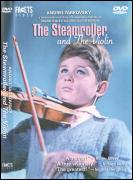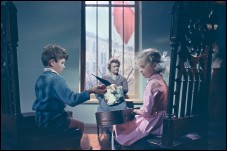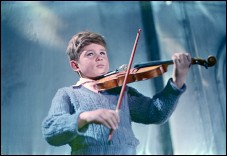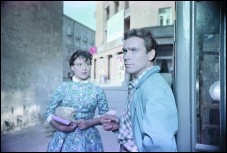
Nostalghia.com looks at...The Steamroller and the ViolinKATOK I SKRIPKA. With Igor Fomchenko, V. Zamansky, and N. Arhangelskaya. Written by Andrei Konchalovsky and Andrei Tarkovsky, from a story by S. Bakhmetyeva. Directed by Andrei Tarkovsky. Camera Operator: Vadim Yusov. Sound: V. Krachkovski. Production Designer: S. Agoyan. Production Director: A. Karetin. Original music: V. Ovchinnikov. Film editing: Lyubov Butuzova. Produced by Mosfilm at the Production Unit of Films for Children. Russian with English subtitles. 1960 / U.S.S.R. / Color. Mosfilm 1960. A copy of Andrei Tarkovsky's The Steamroller and the Violin on DVD has arrived at Nostalghia.com, courtesy of Facets Video, Chicago.To date, this 1960 Tarkovsky film has - as far as we know - only been available on a Japanese Laserdisc (Pioneer) and a Japanese DVD (IVC), on a French VHS/SECAM video tape (Édition Ciné Vidéo Film), as well as on assorted VHS bootlegs, usually a dub of the Pioneer LD, complete with Japanese subtitles for your viewing convenience. The Steamroller and the Violin was broadcast on the Turner Classic Movies Channel (TCM, U.S.A.) during their recent Tarkovsky Film Festival. A side-by-side comparison reveals that the newly released Facets DVD contains a transfer of the movie entirely identical to the one broadcast by TCM, right down to the subtitles. This implies, of course, that the subtitles are burned into the picture and thus cannot be disabled. This may only be a problem for those of you who understand Russian and have no need for the subtitles. Subtitles are colored yellow, and are very easy to read. The movie is presented in its original 4:3 (full-frame) aspect ratio. The transfer is well done, with a stable picture and excellent blacks and contrast. Color and fleshtones appear a bit muted, but considering the nature and age of the source materials, eminently acceptable. Compression artifacts are as good as non-existent, with no blocking effects evident in dark regions of the image. The most glaring defects are scratches and very unsightly reel change markers — but these become less distracting as the movie progresses — as well as a DVD cover image showing poor Igor Fomchenko holding the bow with his left hand. The original movie, as shown in the VGIK screening room, is almost 46
minutes long. The Facets release clocks in at 43 minutes 30 seconds, and
thus runs about 4% too fast, a tell-tale sign that a PALvideo source
was used as the source for the NTSC master. Purists may notice that the audio
track pitch is off by a semitone, but most viewers will most
likely not perceive this unfortunate speedup. The video transfer bit rate
is variable and fairly high, peaking at about 8.5 Mbps. The soundtrack is
the original mono mix, relatively clean, without a significant amount of
disturbing hiss or pops. Sound on the low end is almost
nonexistent and the overall range is rather flat, as would be
expected from an over 40 years old movie. The monaural audio bitrate sits at a very acceptable
192 kbps. The DVD is in the NTSC video format, with no region code, i.e., it
is playable in all "DVD regions." You may now be thinking, "Is this film 'Tarkovskian' enough to be of any real interest? Isn't it really just a cute, but otherwise less-than-interesting, take on the French Albert Lamorisse short The Red Balloon...?" The short answer: This movie has Tarkovsky's fingerprints all over it (no, not literally!). It is indeed highly recommended. No Tarkovsky connoisseur should be without it. It is a true gem, now finally presented in a decent format (DVD), and should not be missed. Yes, this short movie is well-worth its fairly high USD 24.95 price tag. For the long answer, let's take a journey back in time.... to 1960.
A diploma film demanded a high level of attention and guidance. This resulted in a large number of files of minutes of studio discussions. Transcripts of these meetings make for some fascinating reading material, as they offer unique insight into the personality of the director, as well as the problems, ideas, and tensions that arouse during production. It is quite evident that the 28-year old Tarkovsky was a principled, audacious young man, never willing to budge if there was a risk of compromising his vision. As an example of his youthful audacity, he actually wanted to use Sergei Urusevsky, the highly regarded and much sought-after cameraman on the 1958 Cannes winner, Mikhail Kalatozov's The Cranes are Flying, on his diploma film. Urusevsky turned down the offer, of course, which led to the start of fruitful collaboration between Tarkovsky and Vadim Yusov, who was the cameraman on the director's first three feature films. VGIK archive documents reveal that the director's intention with The Steamroller and the Violin was to chart the attempts at contact between two very different worlds, that of art and labor, or, as he referred to it as, "the spiritual and the material." One of the most rewarding moments in the movie is, in our opinion, the point at which the boy innocently and fervently plays his violin to the asphalt layer, demonstrating for the first time (perhaps to both of them) the transcendental power of art. To the warm exciting radiant street-life the director juxtaposes the cold formality of the Conservatoire and attempts to conjoin them in the image of the blind archway whose "arches take on the meaning of a cathedral and where music and human sincerity illuminate it with feeling and talent" [2]. The director's fundamental belief in the seriousness and responsibility of art is here clearly set forth. In the final version of the movie, a few minor scenes in the original Tarkovsky-Konchalovsky script were left out. Only two scenes were changed in some major way, viz. the film's concluding sequence, and a sequence showing a rehearsal for a May Day parade with tanks rolling along city streets. The latter was dropped in favor of the building demolition sequence [2]. Tarkovsky was interested in creating a tragic, threatening atmosphere, the recollection of war, explosions witnessed by Sergei - the driver of the steamroller - at the Front. This idea of the memory of war was instead reinforced by means of the noises at the demolition site and the rumble of thunder. All that remain of the May Day Parade are the large red flags and a solitary number "1" and letter "M" leaning against a wall. The demolition sequence carries with it a sense of celebration of the new and its triumph over the old. A new city, a city of light and reflections. Sergei being one of the builders of the city, embodying its daily life, its street-life, its external rhythm. Interestingly, the new building which emerges in the demolition scene is a prime example of the awful socialist-realist architecture that Andrei absolutely loathed. It was at first somewhat puzzling to us why he would insert this monstrosity into the movie. It may perhaps be explained by the fact that it was indeed a last-minute replacement - he may have been forced to improvise and compromise very quickly... perhaps this scene constitutes "The Last Compromise of Tarkovsky"? We are merely speculating, of course.
"If you extend the normal length of a shot, first you get bored; but if you extend it further still you become interested in it; and if you extend it even more a new quality, a new intensity of attention is born." After working on a screenplay for six months, Tarkovsky clearly knew in his mind what he wanted on the screen, and he stubbornly pursued his vision. In themselves, the actors were already at this early point in his career of no particular interest to him. To the accusations of failing to make his actors - especially the boy - likeable characters, he replied, according to VGIK transcripts: "I cannot use schematic language. I cannot take a positive hero through a positive external reality and make people fall in love with him instantly. I believe that it is not profound, not serious enough; art is not to be created in this way, it is not real. It is hack work." About screen tests for the adult parts in the movie, he would tell the critics: "The screen tests are bad, but as for the conception of the film, I have already stated it clearly and I am going to stick to what has already been decided, otherwise I we will end up with a twee little children's film... It is not the actors that are important, but the idea and the approach. I cannot express anything in a received language." While still virtually unknown, he thus behaved exactly as he was to behave throughout the rest of his life, uncompromising and at times rather undiplomatic, always defending his views of the cinema to anybody willing to listen. Much later, he was able to express his views on the acting profession more concisely, see the article "To the actor, film must be like life itself... a riddle, a secret, a mystery." Finally, in his VGIK essay on Sergey Yutkevich's The Great Warrior Albani Skanderbeg (1945), Tarkovsky states: "Any idea that is offered to the audience not directly, and that is correctly perceived by the audience in spite of the indirect treatment, will be all the more appreciated by the audience because it calls upon the creative efforts of the audience itself" [3].
Yes, The Steamroller and the Violin most definitely
foreshadows the metaphysical eruptions to come. The movie is highly recommended
for all serious students of the art of Andrei Tarkovsky.
©2002 - Trond and Jan / Nostalghia.com.
References and acknowledgements: Nostalghia.com wishes to thank Mr. Ray Privett of Facets Video for providing us with a review copy of the Steamroller and Violin DVD, as well as for providing us with the three beautiful color stills from the movie shown on this page. Much material for this piece has been derived from the following excellent sources: [1] "Films of the young. The Steamroller and the Violin" ("Filmy mlodych. Walec i skrzypce"), published in the Polish magazine "Ekran" in 1961, issue 5, p. 13; excerpts presented here by Nostalghia.com for the first time in English translation. [2] Andrei Tarkovsky, William Powell (Translator), Natasha Synessios (Translator), Collected Screenplays, paperback - 564 pages (September 1999), Faber & Faber; ISBN: 0571142664. [3] Turovskaia, Maiia Iosifovna. Tarkovsky: Cinema as Poetry / Maya Turovskaya ; translated by Natasha Ward; edited and with an introduction by Ian Christie. [Rev. ed.]. London; Boston: Faber and Faber, 1989. Hardcover - 177 pages (April 1990), ISBN 0-571-14709-7. |





